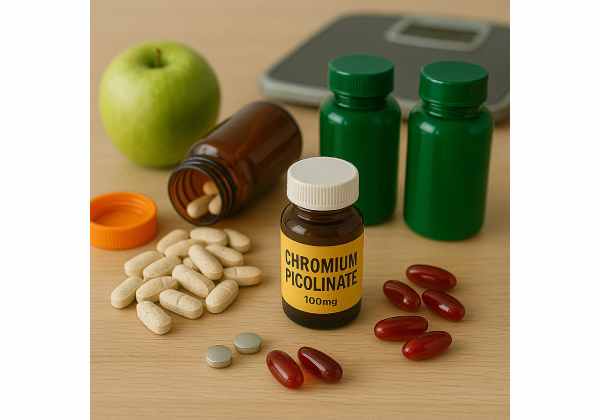
If afternoon sugar hunts or late-night snacking derail your plan, you have probably seen chromium picolinate pitched as a craving fix. Chromium is a trace mineral involved in insulin signaling, and the picolinate form is widely used in supplements. Some people report steadier appetite and fewer sweet cravings, but results vary and claims often outpace data. This guide explains what chromium picolinate can and cannot do, the doses people actually use, and how to decide if a short, structured trial is worth your time. If you are comparing supplements with prescriptions or medical programs, start with our overview of clinically supported options for weight management to see where chromium fits.
Table of Contents
- Does chromium picolinate curb cravings?
- How chromium affects appetite and metabolism
- Effective dose, forms and timing
- Common mistakes and troubleshooting
- Safety, side effects and interactions
- What the research actually shows
- Who should consider chromium and when to skip it
- Frequently asked questions
Does chromium picolinate curb cravings?
Chromium picolinate combines the mineral chromium with picolinic acid to improve absorption. Chromium helps insulin do its job: moving glucose from the bloodstream into cells. When insulin signaling works smoothly, many people experience steadier energy and fewer sharp “eat something now” signals after carb-heavy meals. That is the rationale behind chromium for cravings.
What to expect in real life
Chromium is not a fat burner and it will not melt fat away on its own. At best, it plays a supporting role by smoothing post-meal energy dips and making it easier to stick to portions you already planned. Weight changes linked to chromium alone are typically small. People who begin with insulin resistance, prediabetes, or high refined-carb intake are most likely to notice steadier appetite. If your current diet is already high in protein and fiber—and your glucose control is good—the supplement may feel like a non-event.
How cravings fit into the picture
Cravings have multiple drivers: low protein at meals, erratic sleep, stress, habitual snacking, and big glucose swings after refined carbs. Chromium may help with the glucose-swing piece for some, but it does not fix low protein or too little sleep. Before you trial a supplement, do a quick audit: get 20–40 g of protein at main meals, add soluble fiber (beans, lentils, oats, psyllium), tighten your sleep window, and keep sweet drinks out of the house. When these are in place, you will know whether chromium adds anything meaningful.
A fair way to test chromium for cravings
- Choose two “problem windows” (e.g., 3–5 p.m. and late evening).
- Track hunger and snack frequency for 7 days.
- Start chromium picolinate (details below), keep meals protein-forward, and repeat the same tracking for 14–21 days.
- Keep it only if cravings clearly drop without side effects.
If you are just getting started with habit changes, you will get more mileage by reviewing simple, sustainable steps in healthy weight loss basics and letting chromium be an add-on—not a foundation.
How chromium affects appetite and metabolism
Chromium’s main role is insulin support. Insulin acts like a key, unlocking cells so glucose can move inside. When insulin has to push harder (insulin resistance), glucose and insulin both run higher, and you often get post-meal dips that feel like urgent hunger or fatigue. By improving insulin’s efficiency in some people, chromium can flatten those ups and downs.
Mechanisms in plain language
- Insulin signaling: Chromium appears to enhance the insulin receptor’s activity, which can improve glucose disposal after meals. Smoother glucose responses often mean fewer “I need sugar now” impulses two to three hours later.
- Neurotransmitters: Small studies suggest possible effects on serotonin and dopamine pathways related to mood and reward, which could influence craving intensity. Evidence is mixed and not strong enough to treat mood disorders.
- Lipids and inflammation: Some trials note modest improvements in triglycerides or markers of oxidative stress, especially in people with features of metabolic syndrome. These are supportive, not transformative.
Who feels the appetite effect most
- People with prediabetes, insulin resistance, or PCOS who experience energy crashes after refined-carb meals.
- Heavy afternoon snackers whose lunches are low in protein and low in fiber.
- Individuals who notice cravings when sleep-restricted; chromium may help a little, but the bigger fix is sleep.
Who rarely notices a difference
- Highly active people eating protein-rich, high-fiber diets.
- Those whose cravings are mostly habit or stress-driven; chromium does not replace stress management, planning, or environment design.
If your primary concern is blood sugar swings and you are comparing non-prescription options, you might also read about another insulin-sensitizing supplement in our guide to berberine’s results and safety. The two are sometimes compared, but neither substitutes for fundamentals.
Effective dose, forms and timing
How much do people actually take?
Most trials use 200–1,000 micrograms (mcg) of elemental chromium per day, commonly 200–600 mcg, as chromium picolinate. Start low and titrate:
- Week 1: 200 mcg with a meal (breakfast or lunch).
- Week 2: 200 mcg twice daily with meals if well tolerated.
- Ceiling: Up to 1,000 mcg/day in divided doses if your clinician agrees and you have no side effects. Higher is not better; gastrointestinal issues rise with dose.
Always check labels for elemental chromium per serving, not just “chromium picolinate X mg.” The compound’s weight is larger than the chromium itself.
When to take it
- Take with meals to reduce stomach upset and to target the post-meal window when cravings often appear.
- If afternoons are your problem time, make lunch one of your doses.
- Give chromium 8–12 weeks before deciding to keep it; most people know within 2–4 weeks if cravings have eased.
Forms on the shelf
- Chromium picolinate: Most studied and widely available.
- Chromium polynicotinate or chromium chloride: Also used; choose products that state elemental chromium clearly. Differences in real-world effects are small compared with getting the basics right.
How to pick a product
- Prefer brands that use third-party testing (USP, NSF, Informed Choice) to reduce contamination and ensure dose accuracy.
- Avoid blends that hide chromium dose inside a proprietary formula.
- Keep it simple: one key ingredient, disclosed dose, and clean excipients.
A practical 12-week trial plan
- Log baseline cravings (time of day, intensity) for one week.
- Start 200 mcg with a protein-rich meal. After 3–7 days, consider 200 mcg twice daily.
- Keep meals protein-forward (20–40 g) with soluble fiber (beans, oats, psyllium).
- Reassess at week 4 and week 12. If cravings or snack frequency have not changed—or you have side effects—stop. Your budget and comfort matter.
For help separating quality products from marketing, review why independent certification matters in third-party testing for supplements.
Common mistakes and troubleshooting
1) Expecting chromium to replace meal structure
Chromium cannot fix low protein breakfasts, skipped lunches, or chaotic sleep. If you want fewer cravings, start by adding protein and fiber and setting a consistent bedtime.
2) Confusing “mg of picolinate” with “mcg of chromium”
Labels sometimes list the weight of the compound rather than elemental chromium. You need the elemental chromium number to compare products. When in doubt, choose brands that display both clearly.
3) Taking it on an empty stomach
This increases the chance of nausea without improving appetite outcomes. Dose with meals.
4) Chasing high doses for faster results
More is not better. Benefits plateau, while GI upset, headache, or dizziness become more likely. Respect your ceiling and time horizon.
5) Ignoring interactions
Chromium can enhance glucose-lowering from medications. If you use insulin or sulfonylureas, monitor closely and involve your clinician. Chromium may also reduce levothyroxine absorption; separate by several hours.
6) Stopping after three days
Cravings patterns can be habit-driven. Give your trial 2–4 weeks to judge appetite changes and 8–12 weeks for weight or waist.
7) Skipping label literacy
Proprietary blends, under-dosed products, or unnecessary stimulants complicate results. If label reading is new, skim our primer on how to read supplement labels before you buy.
Troubleshooting quick wins
- Afternoon cravings: Move one dose to lunch, add 20–30 g protein, and keep water visible at your desk.
- Evening snacking: Eat a protein-rich dinner, take a short walk, and set a kitchen cut-off time you can keep.
- No change at week 4: Stop, and redirect effort to higher-leverage steps (protein, fiber, steps, strength training).
Safety, side effects and interactions
For most healthy adults, short-term use of 200–1,000 mcg/day of chromium with meals is generally well tolerated. Still, chromium is not risk-free, and a careful approach matters.
Common side effects
- Gastrointestinal: nausea, abdominal discomfort, gas, constipation, or diarrhea—usually dose-related and eased by taking with food.
- Neurological: headache or lightheadedness in some users; stop if persistent.
- Skin: rare rashes; discontinue if they appear.
Who should not take chromium without medical guidance
- Pregnancy or breastfeeding: safety data are limited—avoid unless your clinician recommends.
- Kidney or liver disease: case reports have linked high-dose, prolonged use to organ issues; involve your specialist.
- Adolescents and children: do not use for weight control.
- Allergy to components in the capsule or tablet.
Medication interactions
- Insulin and sulfonylureas (e.g., glyburide, glipizide): chromium can increase hypoglycemia risk. Monitor glucose; ask your clinician before starting.
- Metformin: usually compatible, but coordinate dosing and monitor for lower glucose if you add chromium.
- Levothyroxine: chromium may interfere with absorption. Separate by 3–4 hours.
- Corticosteroids, acid-suppressing drugs: may alter glucose or mineral handling; discuss timing with your clinician.
Practical safety rules
- Start low, with food, and stay within 1,000 mcg/day unless your clinician directs otherwise.
- Reassess at 8–12 weeks; if you see no benefit or experience side effects, stop.
- Choose independently tested products and keep a simple ingredient list.
If you need more predictable, clinically meaningful weight loss—especially with diabetes, sleep apnea, fatty liver disease, or joint disease—review your eligibility for evidence-based therapies in our guide to metformin’s role in weight loss and related medical options with your clinician.
What the research actually shows
Weight and waist changes
Across trials, chromium picolinate leads to small average losses when used alone—often modest reductions in weight or waist over 8–12 weeks. The effect is more noticeable in people with insulin resistance or diets high in refined carbohydrates and less noticeable in lean, active individuals.
Appetite and cravings
Some participants report lower hunger or fewer sweet cravings, especially in the afternoon. Others notice no change. In studies that also increase protein and fiber, the craving benefit is stronger—suggesting chromium works best as part of a structured meal pattern.
Glucose and lipids
People with prediabetes or type 2 diabetes sometimes show modest improvements in fasting glucose, A1c, triglycerides, or insulin sensitivity over several weeks. These are supportive improvements, not a stand-alone treatment plan.
Safety signals
Short-term use at typical doses is usually well tolerated. Rare reports of kidney or liver issues involve high doses or prolonged unsupervised use. Respect your dose and time horizon, and check in with your clinician if you have chronic conditions.
Bottom line
Chromium picolinate can smooth appetite for some—especially those with insulin resistance and refined-carb heavy meals—but the average effect is small. If a 4–12-week trial reduces snacking and helps you maintain a calorie deficit without side effects, you can keep it. If nothing changes, move on. For context on other modest aids, see how vinegar stacks up in our plain-language review of apple cider vinegar.
Who should consider chromium and when to skip it
Good candidates
- Adults with overweight or obesity who experience afternoon sugar cravings or post-meal energy dips.
- People with prediabetes, insulin resistance, or PCOS who want a gentle, low-stimulant tool to support appetite control.
- Those willing to pair chromium with protein-forward meals, soluble fiber, daily steps, and strength training.
A reasonable trial
- Start 200 mcg/day with food for 3–7 days; if tolerated, increase to 200 mcg twice daily.
- Track cravings and snack frequency; hold other variables steady.
- Decide at week 4 (cravings) and week 12 (weight/waist) whether it earns a spot.
When to skip it
- You have reflux or GI sensitivity aggravated by supplements.
- You are pregnant, breastfeeding, or have kidney/liver disease without specialist guidance.
- You expect prescription-level weight loss from a supplement. Choose the right tool for the job; for some, medical therapy or a procedural route is more appropriate.
Higher-leverage alternatives
- Protein at each meal (20–40 g), plus soluble fiber—the most reliable craving control.
- Sleep: 7–9 hours with a consistent wind-down; short sleep drives cravings.
- Environment design: visible water, prepped produce, fewer trigger foods at home.
- Planned movement: daily steps and 2–3 strength sessions to protect lean mass.
Keep it simple
Chromium picolinate is worth considering if it clearly reduces cravings with no side effects and fits your routine. If not, redirect your effort toward the fundamentals that move the needle most.
Frequently asked questions
What dose of chromium picolinate should I use for cravings?
Start with 200 mcg once daily with a meal. If tolerated, increase to 200 mcg twice daily. Some adults trial up to 1,000 mcg/day with clinician guidance. Higher doses rarely help more and increase chances of nausea, headache, or GI discomfort.
How long does chromium take to work for weight loss?
Expect 2–4 weeks to gauge appetite and snack changes and 8–12 weeks to judge weight or waist. If cravings and intake do not improve by week four—or you notice side effects—stop and refocus on higher-impact steps like protein, fiber, steps, and sleep.
Can I take chromium picolinate with metformin or insulin?
Do not combine without your clinician’s input. Chromium can enhance glucose-lowering, increasing the risk of hypoglycemia with insulin or sulfonylureas. If your clinician approves, monitor glucose closely and adjust prescriptions as directed.
Does chromium picolinate really curb sugar cravings?
Sometimes. People with insulin resistance or carb-heavy meals are more likely to feel steadier energy and fewer sweet cravings. Results are modest and inconsistent. You will see the biggest change when chromium is paired with protein-rich, high-fiber meals and solid sleep.
Is chromium picolinate safe to take long term?
Short-term use at 200–1,000 mcg/day is generally well tolerated. Long-term safety data are limited. If you continue, use the lowest effective dose, take it with food, and check in with your clinician—especially if you have kidney or liver conditions.
Who should avoid chromium picolinate?
Avoid during pregnancy and breastfeeding, in children, and if you have kidney or liver disease unless your specialist approves. People on insulin, sulfonylureas, or levothyroxine should consult their clinician about interactions and timing.
References
- Effects of chromium supplementation on body composition in patients with type 2 diabetes: A dose-response systematic review and meta-analysis of randomized controlled trials. 2024 (Systematic Review).
- Chromium picolinate supplementation for overweight or obese adults. 2013 (Systematic Review).
- Effects of Chromium Picolinate Supplementation on Cardiometabolic Biomarkers in Patients with Type 2 Diabetes Mellitus: a Randomized Clinical Trial. 2020 (RCT).
- Effects of chromium picolinate on food intake and satiety. 2008 (RCT).
- Chromium – Health Professional Fact Sheet. 2022 (Government Fact Sheet).
Disclaimer
This article is educational and does not replace personalized medical advice, diagnosis, or treatment. Always consult your healthcare professional before starting or stopping any supplement—especially if you have diabetes, kidney or liver disease, take insulin, sulfonylureas, or levothyroxine, or are pregnant or breastfeeding.
Share and follow
If this guide helped you decide whether chromium belongs in your plan, consider sharing it with someone weighing similar options. For practical, evidence-based updates on weight, nutrition, and metabolic health, follow us on the social platform you use most—Facebook, X, Instagram, or LinkedIn.










